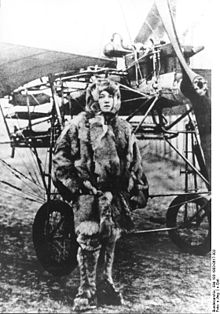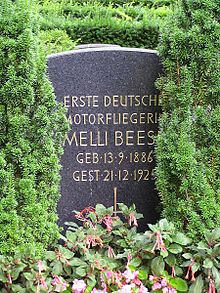Nevertheless, in May of that year she found a new instructor named von Mossner, who allowed her to take complete control of an aeroplane for the first time. Beese, encouraged by this, sought to gain more flying time, and spoke with the director of Johannisthal to this end. The director, Major von Tschudi, anticipated a stir in publicity if he allowed a female aviator to participate in the upcoming flight display, and so at the end of July 1911 Beese was allowed to fly unaided. She encountered several setbacks, including sabotage of her aircraft by other participating aviators. However, she did participate in the flight display, becoming the first female pilot in Germany on 13 September 1911.1912 was an eventful year for Beese. Following her father's death in January, Beese opened a flying school at Johannisthal airfield, with financial assistance from her mother. That same year she used her early training in architecture to design and patent a collapsible aircraft.
She worked with one of her early pupils from her flying school, Charles Boutard, on plans for a flying boat. Her relationship with Boutard became close, and the two married in 1913. After marrying Boutard, Beese became a French citizen, thus making her ineligible to work on German airfields during the war. She was eventually arrested with her husband and tried as "undesirable aliens". Charles Boutard was interned and they moved to Wittstock for the duration of the war.
After the armistice between Germany and the allies was concluded, the Boutards filed suit on claims of compensation for goods confiscated upon Charles' internment. The lawsuits continued for most of the rest of her life, although the value of the claimed compensation decreased with the hyper-inflation that Germany suffered during the Weimar period. Despite the troubles suffered due to the ongoing lawsuits and the economic troubles suffered throughout Germany, Melli planned to make a film documenting her flying. Some pieces were shot and still survive, and were included in a film made by Walter Jerven in 1940.As time passed, the marriage of Boutard and Beese began to deteriorate, and by 1925 they had separated and Beese was living alone in Schmargendorf. Also in 1925 Beese had an unfortunate accident, crashing the aeroplane she was flying when she reapplied for her pilot's license. On 22 December of that year, she shot herself in her Berlin flat. She is buried in the cemetery at Berlin-Schmargendorf.
Nevertheless, in May of that year she found a new instructor named von Mossner, who allowed her to take complete control of an aeroplane for the first time. Beese, encouraged by this, sought to gain more flying time, and spoke with the director of Johannisthal to this end. The director, Major von Tschudi, anticipated a stir in publicity if he allowed a female aviator to participate in the upcoming flight display, and so at the end of July 1911 Beese was allowed to fly unaided. She encountered several setbacks, including sabotage of her aircraft by other participating aviators. However, she did participate in the flight display, becoming the first female pilot in Germany on 13 September 1911.1912 was an eventful year for Beese. Following her father's death in January, Beese opened a flying school at Johannisthal airfield, with financial assistance from her mother. That same year she used her early training in architecture to design and patent a collapsible aircraft.
She worked with one of her early pupils from her flying school, Charles Boutard, on plans for a flying boat. Her relationship with Boutard became close, and the two married in 1913. After marrying Boutard, Beese became a French citizen, thus making her ineligible to work on German airfields during the war. She was eventually arrested with her husband and tried as "undesirable aliens". Charles Boutard was interned and they moved to Wittstock for the duration of the war.
After the armistice between Germany and the allies was concluded, the Boutards filed suit on claims of compensation for goods confiscated upon Charles' internment. The lawsuits continued for most of the rest of her life, although the value of the claimed compensation decreased with the hyper-inflation that Germany suffered during the Weimar period. Despite the troubles suffered due to the ongoing lawsuits and the economic troubles suffered throughout Germany, Melli planned to make a film documenting her flying. Some pieces were shot and still survive, and were included in a film made by Walter Jerven in 1940.As time passed, the marriage of Boutard and Beese began to deteriorate, and by 1925 they had separated and Beese was living alone in Schmargendorf. Also in 1925 Beese had an unfortunate accident, crashing the aeroplane she was flying when she reapplied for her pilot's license. On 22 December of that year, she shot herself in her Berlin flat. She is buried in the cemetery at Berlin-Schmargendorf.
Inscription
ERSTE DEUTSCHE
MOTOFLIEGERIN
Family Members
Sponsored by Ancestry
Advertisement
Records on Ancestry
Advertisement







